Kitchen countertops: features, types and subtleties of choice
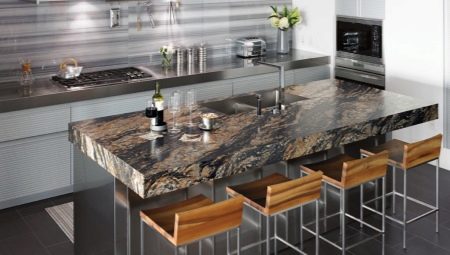
Regardless of how original your unique taste in furniture is, no kitchen can do without countertops. First of all, such a surface performs working functions, since it is on it that all the main work is performed, and it also experiences the maximum impact of negative external factors.
At the same time, it takes up quite a lot of space and is clearly visible, which means that it simply has to look dignified. Therefore, in order for a headset to look attractive and remain functional for many years, you should be as careful as possible in choosing it.
What it is?
In order to avoid various interpretations, we note that the kitchen countertop is the same plate that is mounted on top of the lower row cabinets. It is designed in such a way as not only to be a lid for the contents inside the drawers, but also to successfully perform the functions of another kitchen table, withstanding loads of any level of complexity.
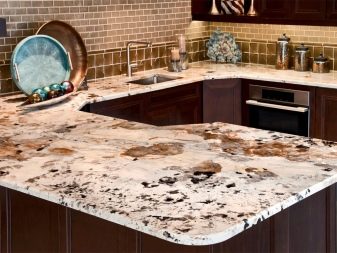

Several decades ago, each kitchen cabinet could have its own lid, but over time, designers have come to the logical conclusion that this is not very convenient. Since then, the worktop has been mounted alone for the entire working area, and hobs, sinks and other useful elements have already been cut into it, if necessary.
Modern countertops should not only be large, but as solid as possible, made from the minimum number of pieces. First of all, this way an increased aestheticism is achieved - there is no difference in levels and uneven gaps.
In addition, even if the plate is made up of interconnected parts, it is these connections that are the weakest points where the probability of product breakdown is higher than anywhere else.

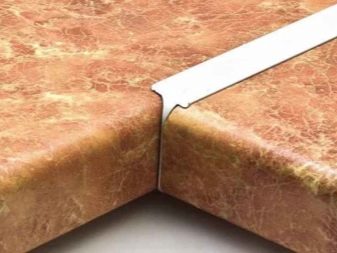
Views
The shape of the kitchen space in our time can be varied, as well as its size. The same applies to the needs of the owners, who may have their own idea of what size and shape the countertop should be. Sometimes the desired seems to be incompatible with reality, but especially for such cases, non-standard types of products are created that allow the most efficient use of space, and sometimes just enhance the aesthetic effect.
The simplest and most common type is predictably straight countertops. - these can be found in most kitchens, they are produced by any enterprise that is generally engaged in the production of plates of this type. They are rectangular in shape and feature a one-piece, seamless design., which allows you to clearly plan the space of the future interior and provides high rigidity and sufficient durability.
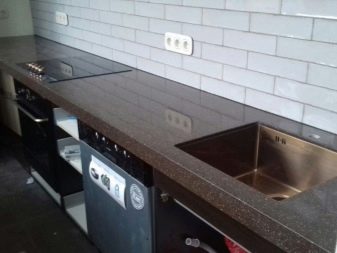
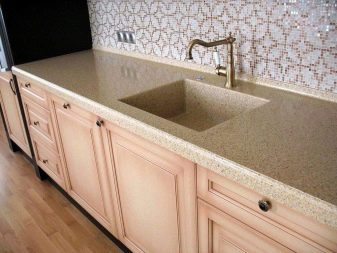
Sometimes kitchens are so cramped that it is not possible to place a full-fledged countertop of the required size there. The solutions to such a problem may turn out to be completely different. The retractable model assumes that part of the two-tier structure is hidden inside the body of the main body.
The slide-out countertop is thinner because it has to fit inside its thicker companion. Usually it is a roll-out board with a locking mechanism in folded and unfolded views.
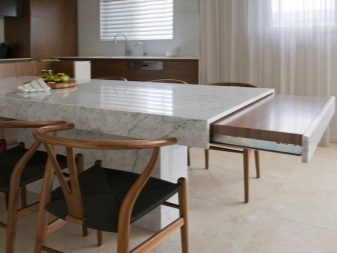

An alternative and slightly simpler solution is a folding tabletop. It is no longer necessarily multilevel, although a lot depends on the reliability of the fasteners. In addition, a certain gap between the two parts does not go anywhere, which means that over time, space and a more noticeable angle may appear between them. But in terms of organization and maintenance, such a model is very simple - when folded, it looks like a two-level or three-level folding transforming board, each layer of which can be shifted to the side.
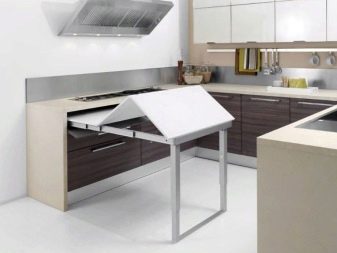
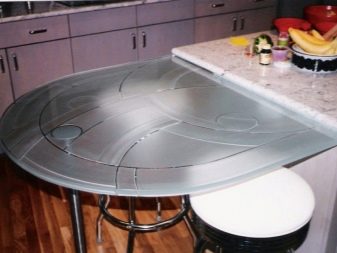
Folding table top today you see it infrequently and yet it also has a right to exist in cramped kitchens. It is a suspended surface that, when folded, practically does not take up space at all, since it is vertically leaning against any of the walls.
If necessary, it can be folded back in the same way as it usually happens with ironing boards - this is very convenient if at the time of receiving guests it is not possible to leave at least a minimum space for the tabletop.
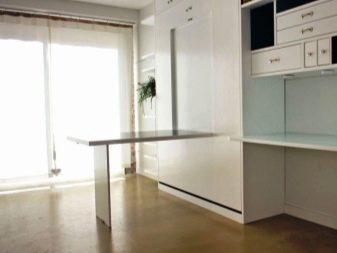

If there are no special problems with space, but you want the kitchen to look smoother and more unusual, you can abandon the traditional rectangular shape in favor of a more refined one. Rounded and radius models play up interestingly the deviations of the working area from the traditional rectangle and look very soft, creating an additional feeling of coziness. In addition, the semicircular edges of the countertops are also good because they are completely safe for children, who, in their pranks, often get injured by hitting a sharp jamb.

Almost any modern countertop, unless we are talking about an impromptu counterpart, should be water resistant. This is understandable, because drops of water from a nearby sink or from freshly washed products will inevitably fall on it. However, a moisture-resistant plate is not yet the ultimate dream, therefore many modern owners choose anti-vandal models... Such a solution is much more effective protected from external influences, which is also very appropriate.
Thanks to a special protective coating, the tabletop is easier to wipe off from grease and any other dirt, as well as from children's "art", it can be more resistant to contact with hot objects.
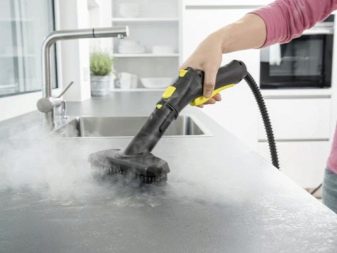
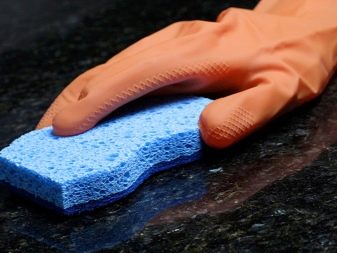
Materials and their characteristics
The material is most directly related to how reliable and durable the selected product will be, therefore special attention should be paid to this criterion. When comparing materials, all characteristics should be taken into account, as well as the potential place of use of the board. It should also be borne in mind that some models are made of several materials at once - so, the body can be solid wood, while on the surface - veneer wood or laminate.
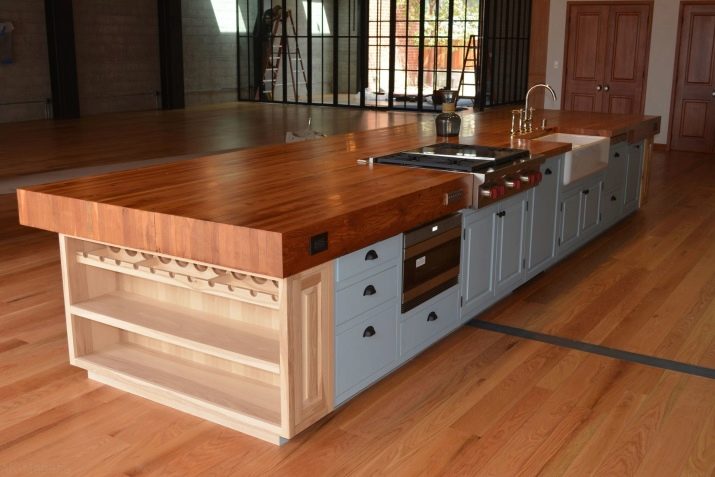
However, each material needs to be considered separately in order to understand what its performance characteristics are.
MDF
Today this material is deservedly one of the most common and by all indications it turns out that in the future the demand for such plates will only grow. In essence, this is an improved chipboard - this material is also made from wood chips, but instead of potentially toxic adhesives, the technology of the most powerful pressing is used here.
Thanks to this, the final product remains environmentally friendly, is inexpensive, and significantly surpasses its fellow chipboard in terms of strength.
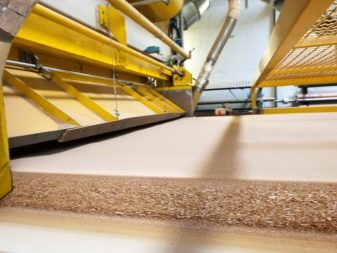
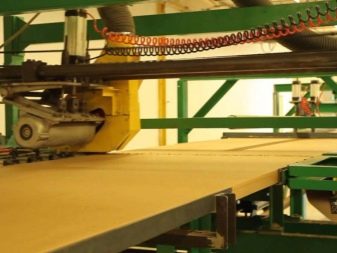
MDF boards are almost always laminated, which additionally protects the product from mechanical damage and absorbing dirt. Nevertheless, both scratches and spots will nevertheless appear over time, therefore design experts usually recommend choosing a matte finish with a multi-colored pattern, which somehow helps to mask the defects that appear.
Unfortunately, laminated tabletops are never seamless, so you will have to connect separate fragments with metal moldings. Pay attention to the issue of sealing such a joint - water entering the gap can get to the base of the stove and provoke its accelerated failure.

Chipboard
A few decades ago, this material was considered one of the most promising, but today it is almost completely out of use and one can hardly expect that it will ever become popular again. Until our time, it is used only by those owners who are always guided by the maximum economy in everything.
Indeed, it is difficult to find at least some alternative that would be cheaper, because chipboard is made from waste from the woodworking industry.
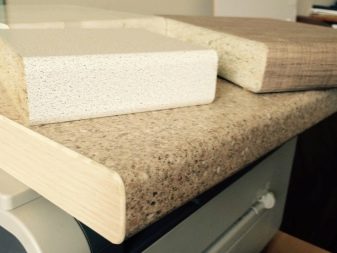
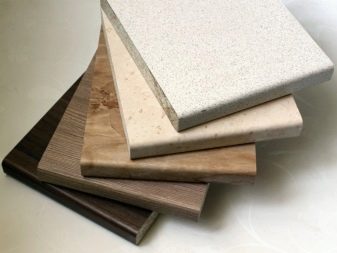
As a rule, the advantages of such material are cheap and end up. For a more reliable connection, adhesives and resins are added to the mixture, which, when heated, can emit harmful fumes. Manufacturers, of course, insist that it is their products that are made with due regard to quality, because they are completely safe. We will not argue that even for chipboard there is a gradation of safety, but the statement that there are supposedly completely harmless types of this material raises doubts.
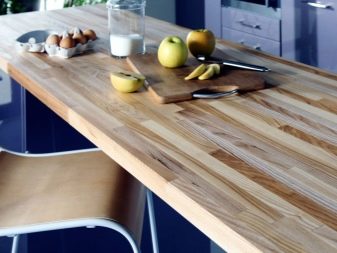
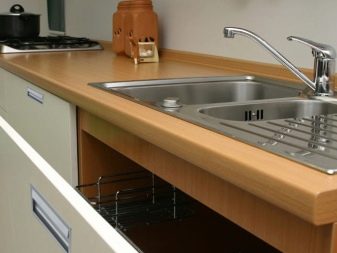
Among other things, chipboard still does not have the outstanding strength that is characteristic of more modern MDF boards. For this reason, today you practically cannot find chipboard in its pure form - at least products made from it are covered with a laminated layer, and often they are also disguised as something else.

If you nevertheless decided to save money, choose a chipboard countertop according to approximately the same criteria as its “colleague” from MDF - a monochromatic glossy coating will probably lose its original appearance faster than a matte pattern.
Glass
The two above-mentioned materials are a massive consumer choice, but glass countertops are already a solution for those owners who are not alien to an individual aesthetic taste. First, it is looks pretty originalbecause your countertop acquires an unusual shine, and if necessary, it can even be completely transparent. Secondly, good glass in general turns out to be quite practical in use - it does not absorb liquids, and therefore is less susceptible to non-removable dirt.
Needless to say, such products are made not of ordinary glass, but of tempered glass.
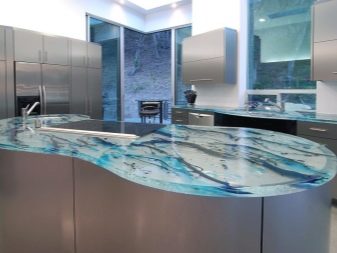
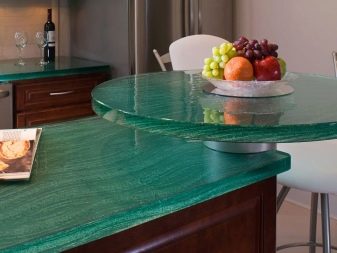
In theory, a glass surface can be custom made in sizes and shapes that the customer himself deems ideal. Besides, it is quite easy to apply any pattern to the glass, and this gives the consumer the opportunity to make the interior of his apartment unique.
Such characteristics attract an increasing number of buyers, but many are stopped by almost the only drawback of such a decision - the fact that such a purchase will be relatively expensive. If you are not ready to spend a lot, the result will not be good, and in the pursuit of savings, you can run into low-quality glass, which is afraid of high temperatures and shocks.
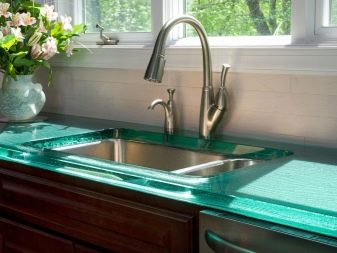
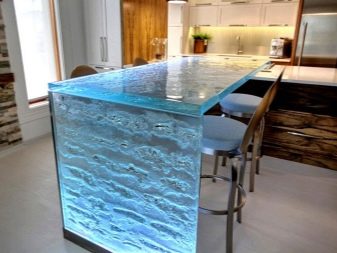
Natural and artificial stone
Those who are chasing solidity and durability often prefer natural stone countertops. Of course, such an acquisition is distinguished by outstanding durability, therefore it is enough to invest money once so that the purchase will serve not only you, but also your children and grandchildren.
Among other things, such an interior detail also looks very solid, and for some design styles it is almost mandatory... True, there are so many difficulties in the implementation of such an idea that nothing will work without their preliminary study.

At the very least, a stone countertop is very expensive, and although such an investment seems justified due to its durability, not every consumer can afford such a purchase. Besides, natural stone should be correctly inscribed in the rest of the interior - firstly, not to be the focal point of the entire room, and secondly, you should take care that everything else in the kitchen is also extremely durable.
Choosing a countertop "for ages", you must be sure that new repairs will not have to be done in ten years, because otherwise the old stove will either determine the style of work, or the expensive thing will simply have to be thrown away.
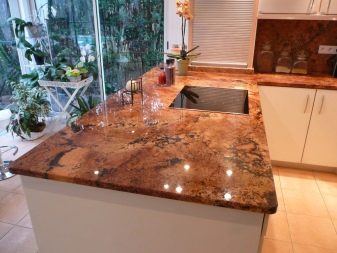
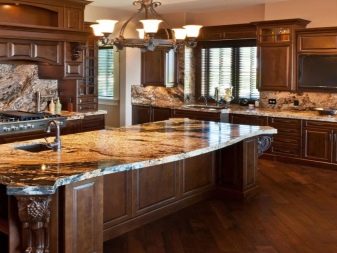
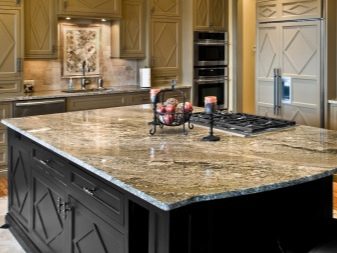
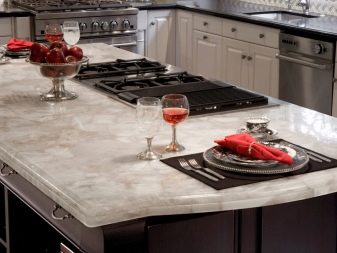
A separate difficulty is the huge weight of natural stone countertops. You can't just take and replace a countertop made of any other stone material. If the emphasis is only on the lower row lockers, then they will most likely simply fold like a house of cards. Therefore, installation involves preliminary calculations and strengthening of the supports so that they can withstand their heavy load.
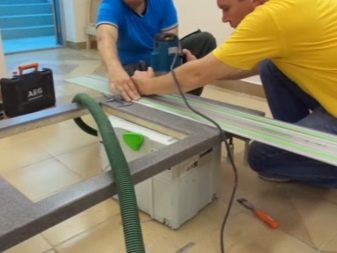
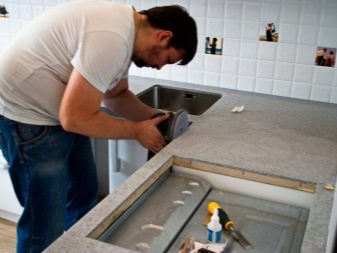
Experts pay attention that natural stone, unlike artificial substitutes, which will be discussed below, has microscopic pores, and therefore visible impurities still remain on its surface. To face such troubles less often, it is worth giving preference to a darker material - on its surface, any contamination is not so obvious.
Wherein in terms of strength and durability, different grades of material are unequal, for example, granite can be safely called the best of its kind, but limestone and even marble are somewhat softer and, if handled carelessly, can still be damaged.
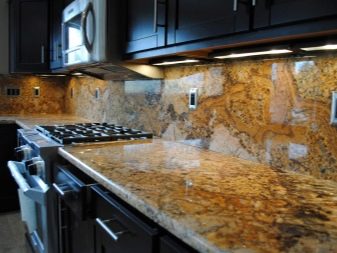
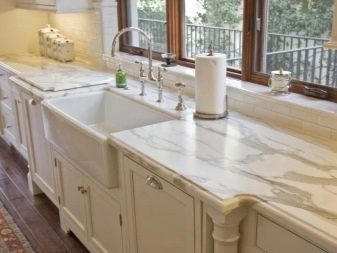
For those who want stone aesthetics, there is an alternative option that allows you to replace natural stone with artificial... This can be implemented in different ways - from specific lamination over even the cheapest chipboard to more complex bulk imitations.
In this case, most of the disadvantages inherent in natural raw materials disappear - the stove turns out to be relatively light and inexpensive.Another thing is that now one can no longer expect either outstanding strength or impressive durability from it, and a trained eye can easily distinguish a natural product from a fake.
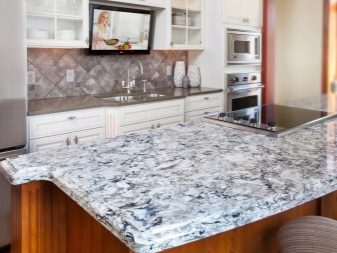
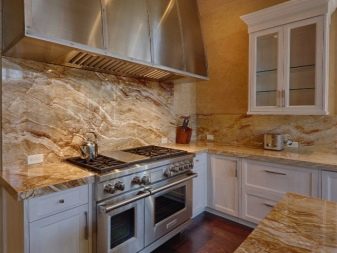
Acrylic
Acrylic is one of the most popular modern materials for making countertops. In a sense, acrylic countertops are the future, not the present, because their use is only gaining momentum, and in the coming years, you can still expect an increase in the share of such products. To understand what is the reason for such a demand, it is enough to look at the list of advantages.
- Acrylic is able to skillfully disguise itself as almost any other popular material, for example, it is often made into artificial stone and artificial wood. The polymer is malleable, at the request of the customer or manufacturer, it can take any shape and be painted in any shade, its surface can be given any texture.
- Acrylic is considered one of the lightest materials therefore, additional support reinforcements are not needed for it.
- It is resistant to any type of impact, not only do not stains remain on it - odors and radiation are also not absorbed into it.
- Such a product can be easily washed using any detergent, but it looks very aesthetically pleasing not only due to the design variability, but also due to invisible seams.
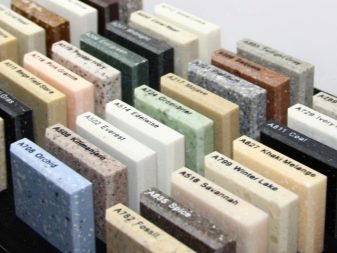

For all its advantages, acrylic also has certain disadvantages. It is not as durable as many of its competitors. - Do not use hard scouring pads or abrasive cleaning agents for cleaning. In addition, you can put a cup of tea on such a tabletop, but not hot dishes that have just been removed from the stove.
The disadvantages of acrylic polymer also include its ability to scratch, although the problem can be solved in two fundamentally different ways: either by choosing a colorful, vibrant pattern that doesn't show any scratches, or polishing to make the slab smooth again.
Finally, acrylic cannot be called the cheapest option - if it is an artificial stone, then it is cheaper than natural, but still more valuable than MDF.
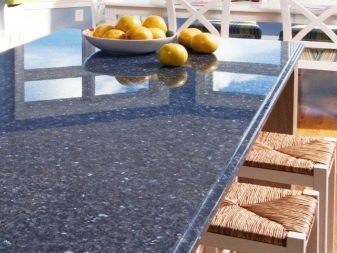
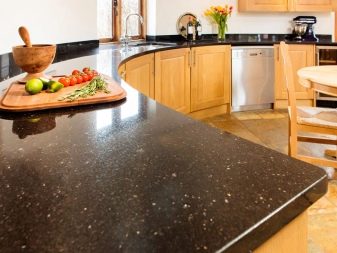
Metal
You don't see metal countertops so often in the kitchen, because they supposedly reduce the feeling of comfort. Maybe for most people this is true, but do not forget about the popularity of interior design styles such as loft, hi-tech or futurism. In all these cases, a stainless steel countertop will not be appropriate - it will seem like an uncontested option.
note that not every metal product is suitable for typical kitchen conditions - stainless steel should be the material. Such a steel tabletop is ideally suited for testing - it does not rust, which means it is not afraid of water, it is not afraid of heating up to several hundred degrees, it is quite easy to wipe off any dirt and has the highest strength. It is extremely difficult to damage such a plate, even if for some reason you are trying to do it purposefully, the potential service life of the product can reach several decades.
As a rule, such an element of the interior does not require any additional finishing and fits into a characteristic modern or industrial design without any preliminary preparation. With all the advantages, such a purchase will not be too expensive for the owners.

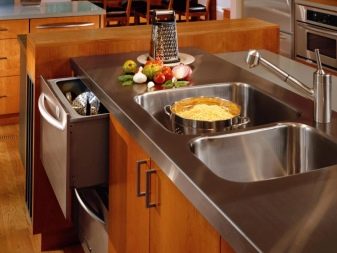
Probably the main disadvantage that negated the use of metal countertops in the kitchen is their inability to fit into most interiors... The abundance of metal parts is uncharacteristic for human habitation, therefore, there should not be too many of them in the kitchen, and after all, there is already at least a stove there.
In addition, any metal has excellent thermal conductivity, and the fact that the heat from a hot stove is not terrible for the worktop itself does not make a person's work more comfortable if the work surface is also heated.Finally, the metal has "Ringing voice"because you are either acting very carefully, or all the neighbors will know that you are engaged in culinary matters.
Unusual options
The modern world literally requires a person to be original in everything, and this also applies to the decoration of the kitchen. In a situation when all possible options have long been invented and exist somewhere, all that remains is to focus on some atypical solution, which, while not being the only one or the first of its kind, is still very rare.
Of course, the options that we will talk about below have more minuses than pluses, otherwise they would be used everywhere, but for those who are chasing uniqueness, even this may seem like an insufficient reason to abandon the venture.
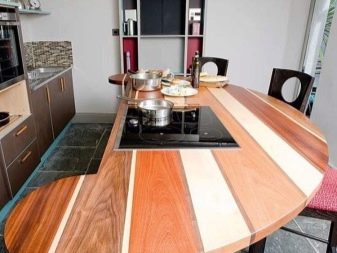
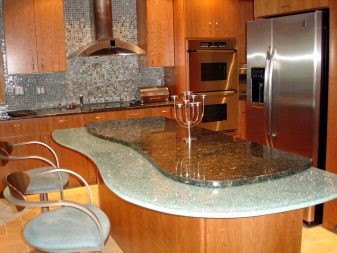
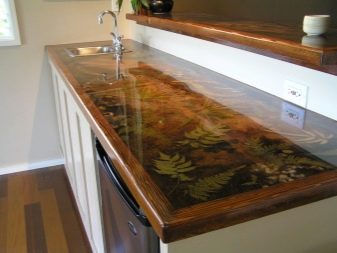
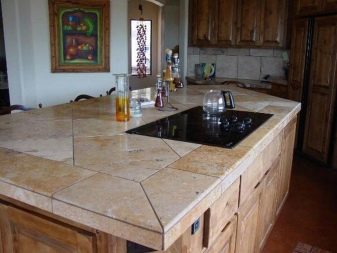
If we talk about relatively rarely used materials, then it is worth starting with ordinary wood. If the above separately considered MDF and chipboard, which are also derived from natural wood, then here we mean exactly solid wood - a solid piece of wood... The factors that force people to consider such a decision are on the surface: this material is environmentally friendly and does not pose any danger to households, and it is also incredibly beautiful.
However, the disadvantages are also obvious, because wood has absolutely no place in the kitchen - it is afraid of both moisture and strong heat, is relatively soft, supports combustion, and absorbs dirt. You can try to combat all this by treating the original material with impregnations and varnishes, but either you will not achieve the expected effect, or the wooden tabletop will no longer look like itself.
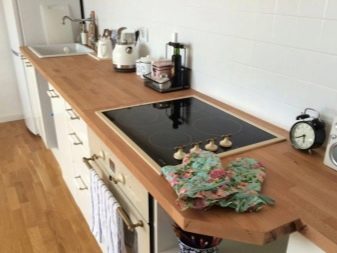
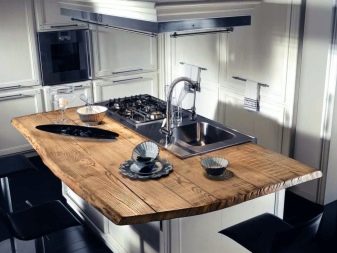
An even stranger solution is a concrete countertop. In principle, if we allow the use of natural stone in the loft style, then it is not surprising that someone decided to go even further and use concrete instead. This, of course, is cheaper than the same granite, and such a product is also quite durable and can have a much more varied appearance if you give it an original shape and add blotches of glass and shells, or even trivially paint it.
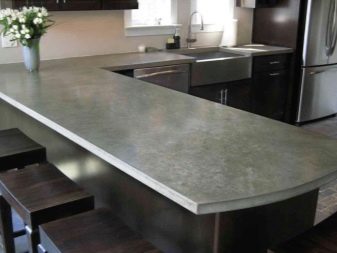

Of course, there are also enough cons:
- not everyone will like such a solution;
- from sudden changes in temperature, the stove can easily crack;
- pores in the structure of concrete contribute to the appearance of stubborn stains, and this problem is solved only by special impregnations;
- a concrete slab is also quite heavy, and additional processing makes it also expensive - we pay a lot, like for a natural stone, and we get a much lower quality surrogate.
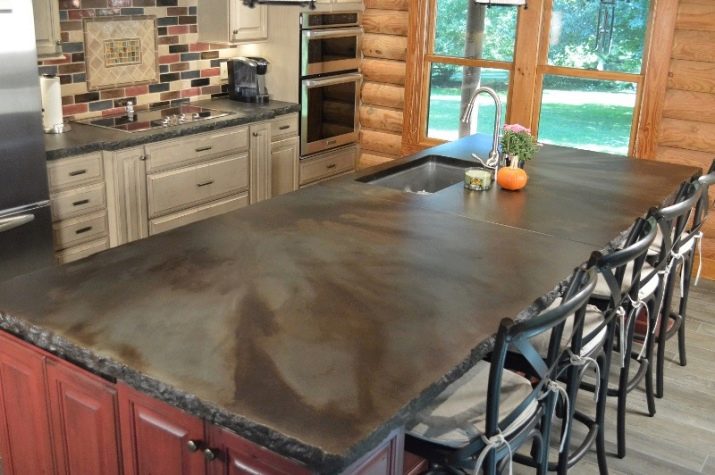
Of the materials that in the coming years may acquire such coveted popularity, ceramic slabs can be distinguished... Such a solution appeared relatively recently; it is a product made of environmentally friendly material - ordinary clay. The ceramic tabletop is not afraid of heat, dirt, or chemicals; on its surface you can even cut with a knife without placing a cutting board.
In terms of originality, a big disadvantage is that in our time such a product can only have a rectangular shape, therefore, its design can be diversified solely due to an unusual print.
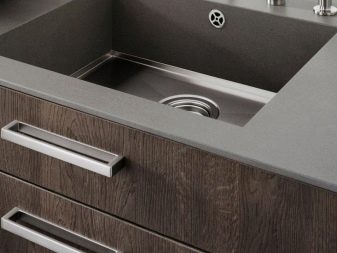
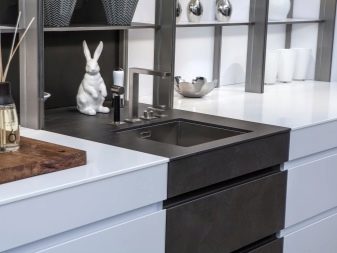
On the Internet, you can also find mentions that the tabletop can be made of drywall... In a sense, this is true, but you need to understand that this material usually represents only an invisible part of the frame, and from the outside it still needs to be trimmed with something else. For this reason, a purely plasterboard countertop, if it occurs, is too pretentious refinement.
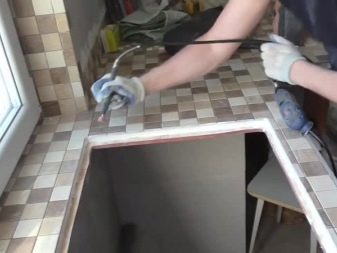
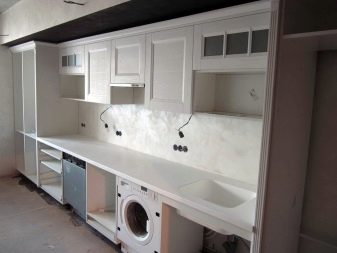
Finally, the last original solution is an epoxy resin countertop... In terms of operational properties, such material seems to be one of the best - it is distinguished by its durability and low cost of raw materials, is not afraid of moisture and is extremely easy to maintain, and also has an impressive appearance and uniqueness. A certain problem is that usually such products are not produced on an industrial scale, and although the designer countertop only benefits from this in terms of originality, its cost naturally increases.
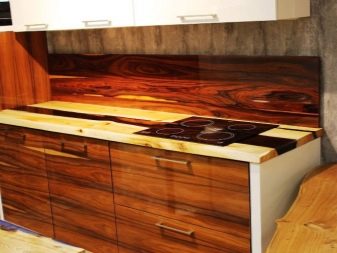
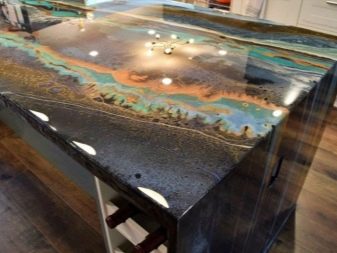
There are not so many cons, but they are - an attempt at homemade production often ends in an unsatisfactory result in the form of a white deposit inside the case, and on contact with hot dishes, the product can release toxins.
In addition, cleaning with harsh scouring pads or abrasives usually has a negative effect on the surface condition.
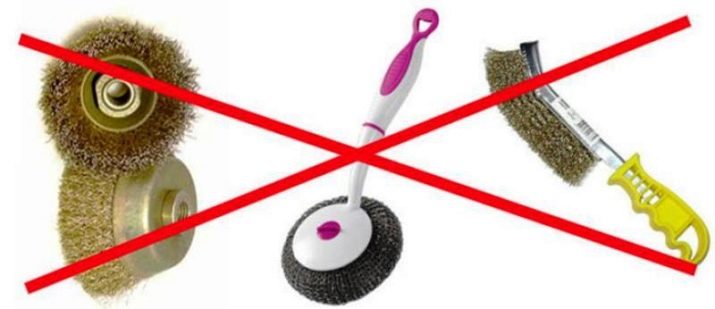
Dimensions (edit)
Many companies not only produce ready-made countertops, but also customize them. The first option is more suitable for those who are not looking for special originality, but agree to a standard version with the benefit of their own finances. Custom-made, of course, is more expensive, but it allows you to realize any of your imaginations.
There is no unambiguous standard for ready-made countertops, but most often they are 60 cm wide and 300 cm long. If necessary, the craftsmen involved in the installation of the product can cut it a little to fit the dimensions of the kitchen, but the increase is usually achieved either by individual production or by joints in the form of moldings. However, many heavy materials have a maximum length limit - exceeding this value, you greatly increase the risk of cracking under your own weight.
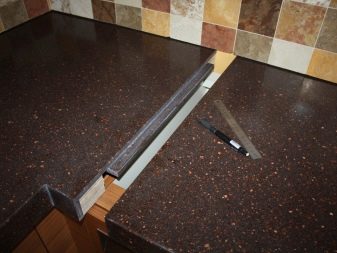
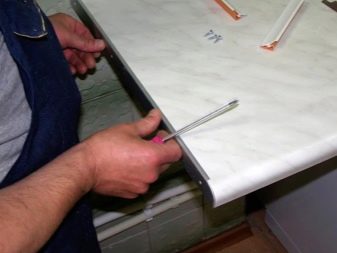
In terms of the choice of thickness, the variety of options is much greater - in the assortment of stores you can find slabs of both 2 cm and 6 cm.In most cases, the thickness does not affect the performance of the countertop in any way - if you do not hit it with a swing with a hammer, it even in the thinnest version it will withstand all possible loads.
Color solutions
In terms of choosing a shade, the same rule works as in the case of sizes: the most basic options can be purchased at a cheaper price in any building hypermarket, but those who are looking for something truly original will have to fork out additionally for a designer copy. The latter, however, can claim real uniqueness if you decide not just to decorate it with a banal pattern, but choose some completely meaningful image.

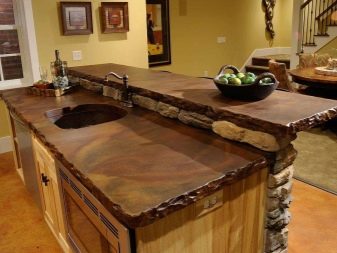
By the way, color has a direct bearing on the durability of the product... So, experts advise to abandon glossy countertops in favor of matte ones - at least if the material can potentially be scratched with the same knife. The fact is that on a shiny surface, any defects are clearly visible to the naked eye, they themselves will attract the eye, which means that soon there will be a need for repeated repairs.
By the same logic, it is advised to abandon a solid monochromatic color in favor of a drawing. Not only that such a stylish design will make the atmosphere of your kitchen indescribable, it will also mask any mechanical damageas they will subconsciously be perceived as part of the image until they clearly violate it.
But thanks to the colorfulness, you can use sparkles if you really lack a glossy surface - if such decorations are illogically scattered over the surface of the countertop, the violation of the structure caused by the scratch that appears will not be noticeable.
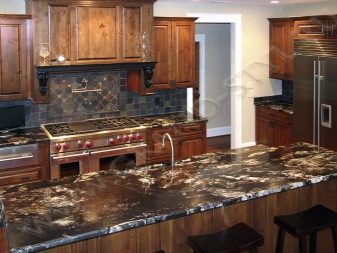

Needless to say, modern countertops come in the most unexpected colors and styles - sometimes it's not the first time to determine what the panel is made of. So, a common pattern is bamboo, from which countertops are not actually made. Imitation of other material is appropriate in a situation where you cannot afford it due to lack of finance or the impracticality of the desired material in the kitchen.
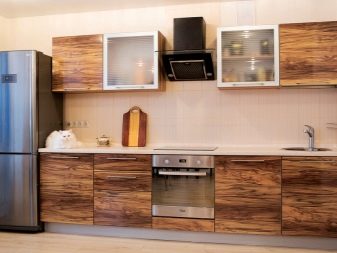
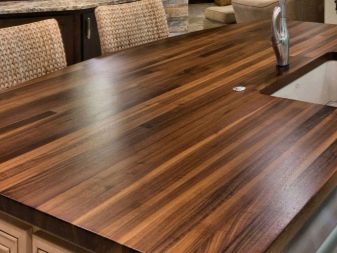
We take into account the style
A tabletop made of any material, even the most beautiful one, can look like a completely foreign body in the interior if you chose it without thinking about stylistic compatibility.Clear rules have long been spelled out by designers and you just need to adhere to them so that things that are good individually remain the same in combination with each other.
Simple example: styles like country, vintage, rustic and classic, a priori cannot assume the use of concrete or metal countertops... All these design directions are guided by the design principles that were available to our ancestors, even relatively poor ones, several decades or even centuries ago.
In all cases, the emphasis is only on natural materials, and all accessories should seem homemade, not factory-made. Accordingly, the ceramic countertop is also unlikely to fit into the classic interior - although ceramics have been known to people since antiquity, they are unlikely to make three-meter-long products from fired clay at home.
It is clear that you may not have enough money or patience for natural wood, but for this, various skillful imitations were created.
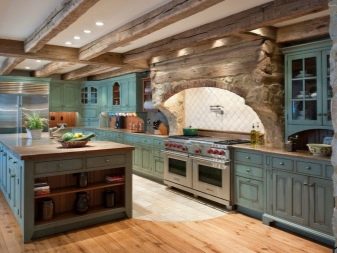
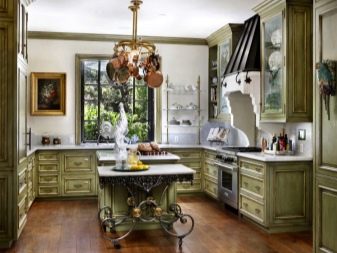
In the same way, you cannot combine the incompatible if you are targeting specific modern loft styles or minimalism. The loft is characterized by a certain coldness of design; it should have the atmosphere of an abandoned industrial facility, therefore, cozy wood, and even with warm patterns on the surface, will seem simply inappropriate here.
Minimalism does not accept an abundance of details, therefore, for him, in principle, a multicolor design is undesirable, and this is why he is fundamentally against the same countertops made of epoxy resin.
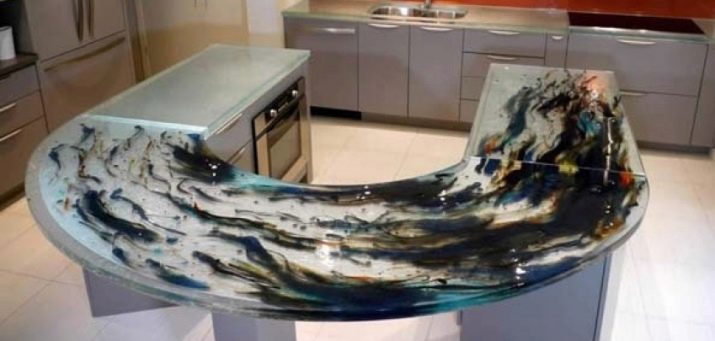
How to choose?
As you can see, there is no ideal material from which a universal headset cover could be made - this is the reason for the variety of options. Whether you're looking at beautiful off-the-shelf designs in a store or coming up with a custom-made project, it's important to focus on the product's practicality.
In many ways, the requirements for the countertop depend on the conditions in which it will be used, because for an outdoor kitchen, the ability to withstand not only heating, but also cooling is extremely important, and this is not required in a home kitchen.
Evaluate potential "candidates" according to the following characteristics:
- resistance to moisture;
- the ability not to deteriorate from temperature extremes;
- susceptibility to contamination and ease of removal;
- abrasion and cut resistance;
- ability to withstand impacts;
- ease of regular maintenance;
- solid structure or the presence of joints - potential weak points;
- ease of installation;
- the likelihood of success with a partial repair of the product;
- the ability to fit into the interior;
- purchase and installation cost;
- durability.
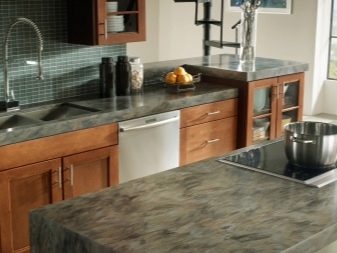
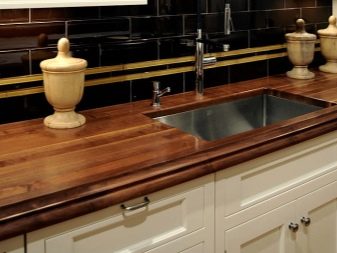
The abundance of available options exists precisely because there are a lot of evaluation criteria, and for someone it may seem ideal that the countertop that another for his kitchen would never have chosen. Therefore, try not to listen to other people's advice, if they are not supported by specific argumentation, starting from the realities of your particular home, and choose the material for the kitchen accessory yourself soberly and thoroughly.
Operation and care
Theoretically, you should have turned your attention to this aspect even during the selection process, but if this was not suddenly done, and the countertop was already mounted, at least now take an interest in how to properly handle the kitchen surface. In the relevant section above, it was clearly shown that any of the available materials has at least one obvious drawback.
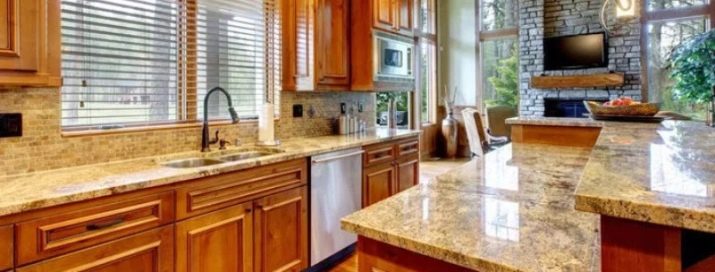
It's good if you guess about it, but frank surprises also happen. So, do not put hot on the epoxy countertop, otherwise it will start to release toxins: without seeing this, you may not even suspect that you are poisoning the whole family.It, as well as some other types of surfaces, cannot be cleaned with abrasive products, therefore, sometimes, trying to remove a stubborn stain, you can completely ruin the stove.
Most types of wood will also not appreciate contact with hot dishes, but for metal or ceramics this will not have any serious visible consequences.
How well you handle your worktop will determine its actual lifespan. Agree, if natural stone easily absorbs dirt and soon becomes covered with well-visible spots, then it does not matter that it could serve for several more decades - it has already lost its original aesthetic appearance, and therefore will no longer please the owners of the apartment with its presence.
For information on how to choose the right countertop for the kitchen, see the next video.








